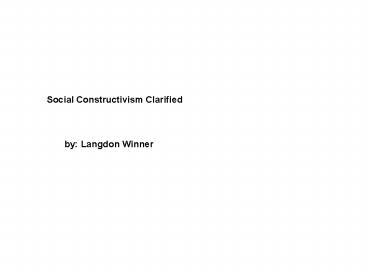Social Constructivism Clarified - PowerPoint PPT Presentation
1 / 18
Title:
Social Constructivism Clarified
Description:
by observing the action of 'phlogiston.' Best 19th century chemistry: There is no such. thing as a 'phlogiston.' Combustion can be. explained by the interactions ... – PowerPoint PPT presentation
Number of Views:127
Avg rating:3.0/5.0
Title: Social Constructivism Clarified
1
Social Constructivism Clarified
by Langdon Winner
2
Conventional view of scientific knowledge
- Scientists investigate, experiment, and employ
rigorous methods to make discoveries and find
the truth. - What guarantees the reliability of scientific
discoveries and truths is objective reality
nature as it actually is.
3
Social constructivist view of science -- What
scientists claim to be facts of nature
sometimes undergo radical change. -- One cannot
explain change in science by looking at the
steady movement from falsehood to the
discovery of truth.
4
Example How can one explain what happens in
combustion? Best 18th century chemistry It
can be explained by observing the action of
phlogiston. Best 19th century chemistry
There is no such thing as a phlogiston.
Combustion can be explained by the interactions
of atoms of oxygen with other substances at
high temperatures.
5
Social constructivist method Do not pre-judge
what is true or real in scientific
inquiries. Give fair, symmetrical accounts of
knowledge claims and follow the social groups
that promote these claims.
6
Contemporary exampleGreenhouse gases and global
warming --Conventional view Scientific
evidence establishes the truth of global
warming and its cause greenhouse gasses. But
some people still dispute this truth, calling
the evidence faulty.
7
Social constructivist view Various social
groups, including scientists, advance knowledge
claims about global warming and its causes.
They form social networks that either support or
deny these claims. The stronger social network
wins! Its knowledge claims become
facts commonly known in society.
8
Social constructivist lessons Make no
assumptions about truths in nature. Always
notice the interactions of social groups and how
these interactions construct widely accepted
knowledge.
9
As applied to technology and design, The
conventional view Ingenious inventors introduce
useful artifacts in exquisite acts of
creativity. Society recognizes the usefulness of
the invention and adopts it.
10
Example In 1878 Bayliss and Thompson
invent the bicycle in England. Over the next
decades society adopts the bicycle in common
use. In the course of time the bike is modified
as designers and producers find ways to make it
more useful.
11
Social constructivist view We misunderstand
technological change by emphasizing inventors and
isolated designers. Useful artifacts emerge in a
complex, many-centered process of social
construction. Different social actors identify
different problems, solutions and functions.
12
Eventually the complex, sometimes chaotic process
in the social construction of any useful device
or technical system stabilizes. Social
constructivists call this final step closure.
There is widespread consensus about what the
technology is and what its uses are. Competing
views (and designs) fade away.
13
Historical example The bicycle was socially
constructed by the interactions of numerous
groups sportsmen, women, tourists, bicycle
producers, etc. Many designs were given a
try. In the early 20th century the bicycle
achieved closure in the design of modern
safety bicycle.
14
More recent example Who invented the personal
computer? Conventional answer It was
invented Steven Jobs and Steven Wozniak in a
garage in Santa Clara County, CA - the original
Apple computer.
15
Social Constructivist view The personal
computer was a social construction that involved
the complex interactions of numerous groups
and individuals defense contractors,
hobbyists, several domestic firms, etc.
16
Many proposed configurations of hardware and
software were tried and had enthusiastic
promoters. In the middle 1980s the PC
achieved closure in the relatively
similar models produced by Apple, IBM and other
firms.
17
Lessons of the social construction of technology
-- Do not pre-judge what a successful
invention or design is in the process of
technological change. (Youll miss too
much!) -- Give fair, symmetrical accounts of
different ideas about problems, solutions and
designs including failures.
18
Another lesson
-- Follow the social groups, social interactions
and conflicts that happen in the process of
design.































